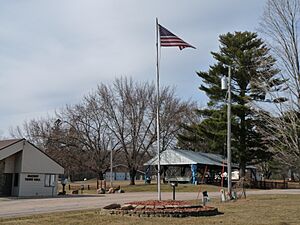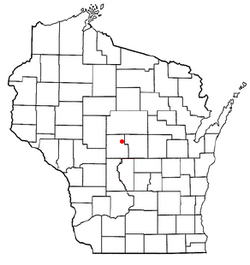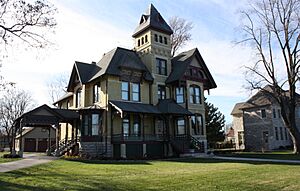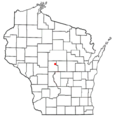Sherry, Wisconsin facts for kids
Quick facts for kids
Town of Sherry, Wisconsin
|
|
|---|---|

Town hall and park in the hamlet of Sherry, in March
|
|

Location of the Town of Sherry, Wisconsin
|
|
| Country | |
| State | |
| County | Wood |
| Area | |
| • Total | 35.4 sq mi (91.6 km2) |
| • Land | 35.3 sq mi (91.3 km2) |
| • Water | 0.1 sq mi (0.3 km2) |
| Elevation | 1,171 ft (357 m) |
| Population
(2000)
|
|
| • Total | 809 |
| • Density | 22.9/sq mi (8.9/km2) |
| Time zone | UTC-6 (Central (CST)) |
| • Summer (DST) | UTC-5 (CDT) |
| Area code(s) | 715 & 534 |
| FIPS code | 55-73475 |
| GNIS feature ID | 1584149 |
| PLSS township | T24N R5E |
| Website | http://www.townofsherry.com |
The Town of Sherry is a small community located in Wood County, Wisconsin, in the United States. A "town" in Wisconsin is a type of local government area, similar to a township. In 2000, about 809 people lived here. The main part of Sherry, which is an unincorporated community (meaning it's not a separate city or village), is found where County Highways N and F meet. This spot is about 3.5 miles (5.6 km) west-southwest of Milladore.
Contents
History of Sherry, Wisconsin
Early Land Surveys and Natural Features
In June 1851, government workers surveyed the land that would later become the Town of Sherry. They used tools like a Gunter's chain and a Solar compass to map out the area. The land was about six miles (10 km) square.
After their survey, they described the area. They noted that the land was covered with many trees, especially Maple, Oak, Birch, and Pine. Near Mill Creek, they found some good pine trees. They also saw thick alder bushes near small streams, often caused by Beaver dams. The streams would rise and fall quickly. The soil was dark and good for farming, but the surface had many reddish stones.
How Sherry Got Started
The community of Sherry began in 1880. A man named Henry Sherry and his business partner, Briggs, opened a sawmill on Mill Creek. A sawmill cuts logs into lumber. They also had a company store, which was a place where workers could buy supplies. This attracted many workers, and the community started to grow.
Henry Sherry continued to run the sawmill with different partners. He also added a planing mill, which smoothed out lumber, and a factory that made barrel staves (pieces of wood used to make barrels). In those early years, the community also had a blacksmith, who made and repaired metal items.
Education and Communication
Sherry's first school opened in 1881, allowing children in the area to get an education. A post office was set up in Sherry in 1884. This made it easier for people to send and receive mail. The post office stayed open for many years, finally closing in 1968.
Henry Sherry's Business Empire
Henry Sherry, the person the town is named after, did not live in Sherry itself. He lived in Neenah. He was the son of a flour miller and became a very successful businessman. In the 1880s, he owned many sawmills, not just the one in Sherry. His sawmills were located in several Wisconsin towns, including Oshkosh, Fond du Lac, Centralia, Auburndale, Milladore, Vesper, Marshfield, Aniwa, Kent, Mineral Lake, and Park Falls.
Town Establishment and Growth
The official Town of Sherry, which is a government area covering about 36 square miles, was created in 1885. It was named after the community that had grown around Henry Sherry's sawmill. The main part of the community, often called Sherry village, was officially mapped out in 1899.
Around 1900, the Presbyterian church group in Sherry formed. They built their brick church in 1903. The German Lutherans built their church just one year later. In 1906, some Presbyterians started a Christian high school called the Northwest Collegiate Institute. It was on a large 500-acre farm along Mill Creek. Students could work on the farm to help pay for their schooling. This school operated until 1921.
By 1923, the village of Sherry had grown to include two general stores (where people could buy many different things), a hotel, a garage, a cheese factory, and a real estate office. A stagecoach service ran twice a day from Sherry village to the railroad station in Blenker, which was two miles away.
Geography of Sherry
The Town of Sherry covers a total area of about 35.4 square miles (91.6 square kilometers). Most of this area, about 35.3 square miles (91.3 square kilometers), is land. A very small part, about 0.1 square miles (0.3 square kilometers), is water.
People of Sherry
Population and Diversity
According to the 2000 census, there were 809 people living in the Town of Sherry. The population density was about 22.9 people per square mile (8.9 people per square kilometer). Most residents were White (96.79%). There were also small percentages of Native American, Asian, and people from other backgrounds. About 0.99% of the population identified as Hispanic or Latino.
Households and Families
In 2000, there were 270 households in Sherry. A household is a group of people living together in one home. Out of these, 217 were families. Many households (44.4%) had children under 18 living with them. Most families (70.7%) were married couples living together. The average household had 3.00 people, and the average family had 3.36 people.
Age Distribution
The population in Sherry was spread out across different age groups. About 30.8% of the people were under 18 years old. About 8.7% were between 18 and 24, and 30.7% were between 25 and 44. People aged 45 to 64 made up 20.6% of the population, and 9.3% were 65 years or older. The average age in the town was 35 years. For every 100 females, there were about 103.8 males.
Income and Economy
In 2000, the average income for a household in Sherry was $52,143 per year. For families, the average income was $53,036. Men generally earned more than women, with a median income of $33,250 for males and $25,341 for females. The average income per person in the town was $17,728. A small percentage of families (1.8%) and individuals (2.3%) lived below the poverty line.
Notable People from Sherry
- Herman Finger – He was a successful lumberman who worked for the Sherry Lumber Company.
- Jacob J. Iverson – He was a farmer, a politician (someone involved in government), and a businessman who lived in the town.
- Henry Sherry – He was the person the town is named after. He owned the Sherry Lumber Company and his house in Neenah is now a historic site.
Images for kids
See also
 In Spanish: Sherry (Wisconsin) para niños
In Spanish: Sherry (Wisconsin) para niños





